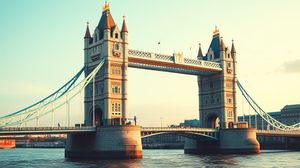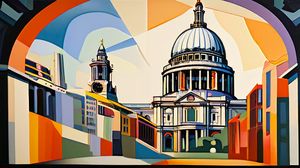
The River Thames is an iconic and historic waterway flowing through London, providing a picturesque backdrop to the city. As the longest river entirely in England and the second longest in the United Kingdom, it stretches over 215 miles from its source in Gloucestershire to the Thames Estuary in the North Sea. Throughout history, the Thames has played a vital role in shaping London's economy, culture, and geography.
A fascinating fact about the Thames is its tidal nature; it experiences a notable tidal range due to its proximity to the sea, affecting water levels and creating unique environmental conditions for diverse wildlife and plant life. This tidal influence is particularly evident in London, where the river acts as more than just a scenic landmark, but also a vital ecological zone.
Over the centuries, the River Thames has been a significant transport route and a source of inspiration for artists, writers, and poets. The riverbanks are lined with historic landmarks, including the Houses of Parliament and the Tower of London, representing its centrality to the city's identity. The river has been immortalized in countless artworks and literary works, highlighting its cultural importance.
An unusual and lesser-known aspect of the Thames is the presence of several hidden 'beaches' along its banks. During low tide, areas like the South Bank reveal stretches of gravel where one can see remnants from centuries past, such as clay pipes and pottery, offering a tangible connection to history.
The Thames is also home to numerous annual events and traditions, including the renowned Oxford and Cambridge Boat Race, which attracts thousands of spectators along its banks every spring. These events celebrate the river's enduring role in British sporting traditions and community life.

Making the Most of Your Visit:
Try taking a leisurely stroll along the Thames Path, especially around the South Bank. Here you can find plenty of street performers, unique shops, and lovely cafes, all with that stunning river view.
If you're fascinated by history, visit the hidden 'beaches' along the Thames at low tide. They're a little secret of London where you can search for old clay pipes or even pieces of pottery from earlier centuries. Just remember to check the tide times first!
For a different perspective, consider hopping on a Thames Clipper boat service. They're a part of London's public transport network, and it's a wonderfully scenic way to travel key parts of the city — much more enjoyable than a typical bus or tube ride!
If you're around at the right time, make sure to catch one of the classic events on the river. The annual Oxford and Cambridge Boat Race is a must-see in spring, with an electric atmosphere along the banks.
Keep an eye out for art installations along the river. From sculptures to murals, the Thames is like an ever-changing gallery with contemporary works that pop up from time to time.

Visiting Times & Costs:
The Thames River is accessible to the public throughout the year with no general entrance fee required. Visitors can enjoy various public pathways and views along its banks at any time. However, note that some specific attractions or tours on the river itself, like boat rides or entry to certain historic sites, may have individual operating hours and associated costs.
Accessibility:
- The Thames Path is generally accessible, with many stretches suitable for wheelchair users, though some areas may have uneven surfaces or steps.
- Access to boats or ferries like the Thames Clipper may have specific accessibility arrangements, so checking with operators in advance is recommended.

Address & Map:

Nearby:























